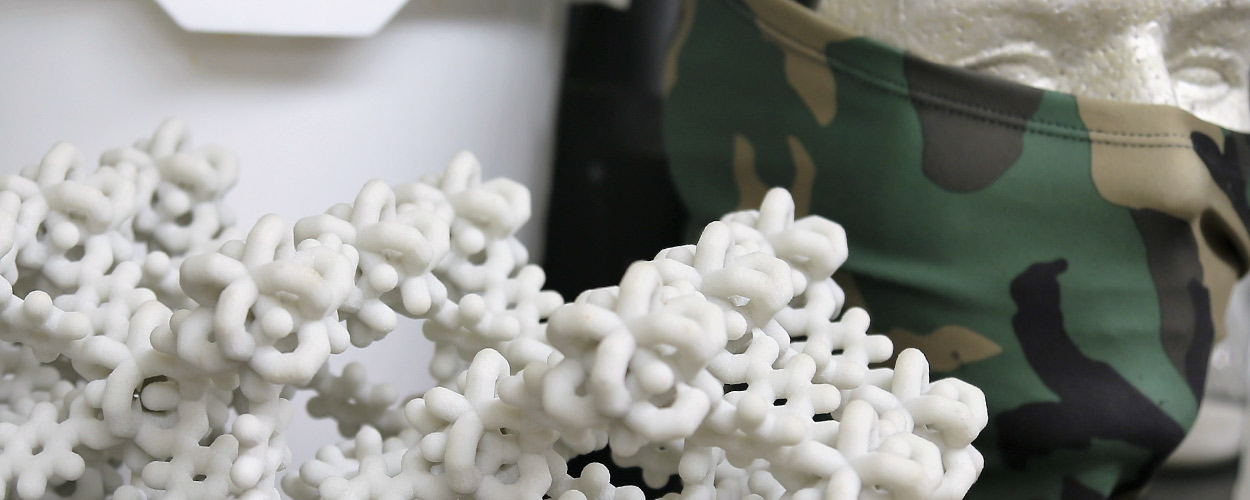Army ManTech Ramps Up MOF Production for New Filters, Textiles
Army ManTech Ramps Up MOF Production for New Filters, Textiles
Provided by CCDC Chemical Biological Center Public Affairs Office
Recent funding will allow the U.S. Army Combat Capabilities Development Command (CCDC) Chemical Biological Center to significantly scale up the production of metal-organic frameworks (MOFs), a promising substance with the potential to support a range of new products dealing with decontamination and filtration.
MOFs, which have proven to be highly effective filtration materials and decontaminants, are being incorporated into a range of technologies. Due to their ability to react with and decontaminate toxic substances and chemical warfare agents, they are being considered for use in self-decontaminating suits and filter masks, among other capabilities.
A relative newcomer to the field of chemical biological defense, MOFs are able to hydrolyze nerve agents and oxidize blister agents, thereby neutralizing toxic substances. When exposed to light, these MOFs react with and excite oxygen. In turn, oxygen reacts with and combines with agent, effectively neutralizing the threat. MOFs also have shown unprecedented reactivity for high volatility toxic gases such as chlorine and nitrogen dioxide.
“Metal-organic frameworks have shown significant promise in a wide range of applications,” said CCDC Chemical Biological Center research chemical engineer Greg Peterson. “For the Center, these applications include filtration, protection in the form of suits, decontamination with wipes and sprays, detection and obscuration.”
While MOFs have demonstrated an ability to provide unique capabilities, scaling had been a challenge due to lack of funding.
However, with new funds from ManTech, a U.S. Army program that invests in emerging technologies and develops advanced manufacturing processes, the Center is contracting with a private company to scale production.
A start of work meeting was held in mid-October 2018. The Center has contracted with a private company to scale production.
“The Army ManTech Program facilitates that maturation and acceleration of advanced manufacturing processes,” said CCDC Chemical Biological Center supervisory engineer Kevin Wallace, who represents the Center to the Army ManTech Office. “Currently, MOFs are produced in small volumes at a high cost. One of the main objectives is to help industry get to higher volumes and significantly drive down costs. When we accomplish that, it becomes a cost-effective enabler for filtration technologies.”
Our initial main focus will be to develop scaled MOFs for incorporation into JSGPM M61 filters."CCDC Chemical Biological Center Research Chemical Engineer, Greg Peterson
Once production is scaled up, Peterson envisions being able to simultaneously incorporate MOFs into different capabilities, putting most of the initial focus on filters.
“Our initial main focus will be to develop scaled MOFs for incorporation into JSGPM M61 filters in an attempt to meet objective requirements,” Peterson said, noting that MOFs offer stronger protection against threats like nerve agent and nitrogen dioxide. “Later, we will focus on developing technologies that we can push to the warfighter. These might include things like protective scarfs and reactive suits.”
Peterson anticipates a two to three year timeline for incorporating MOFs into the JSGPM M61 filter.
Overall, the program is planned to continue for five years concluding in fiscal year 2022, with incremental funding each fiscal year, Wallace said.
Periodic reviews will also evaluate how the technology supports the Army’s strategic priorities, like next-generation combat vehicles.
“The challenge lies in the transition to the Army Futures Command,” Wallace said. Will there be work for us to demonstrate how this technology is applicable to the Army’s modernization priorities? Soldier lethality is where we see MOFs having the most impact, but this is a cross-cutting technology with applicability across multiple modernization priorities.”
Wallace noted that vehicles, aircrafts and ships also integrate collective protection and MOFs could be a candidate to enhance that capability.
“The purpose of it is to build up capabilities in industry that don’t really exist but have an inherent benefit to the military,” Peterson said. “It looks at emerging technologies and developing processes and scalability for these technologies.”
Peterson said the partnership opens up a number of possibilities, including a partnership with the U.S. Army Combat Capabilities Development Command (CCDC) Soldier Center to develop a reactive suit.
“Once we hit the ground running with these filter prototypes we can really get into fabrics and textiles,” Peterson added. “I don’t want to just make a new filter. This opens up a whole new area for research for technologies that don’t currently exist.”
MOF's are being considered for use in self-decontaminating suits and filter masks, among other capabilities.

